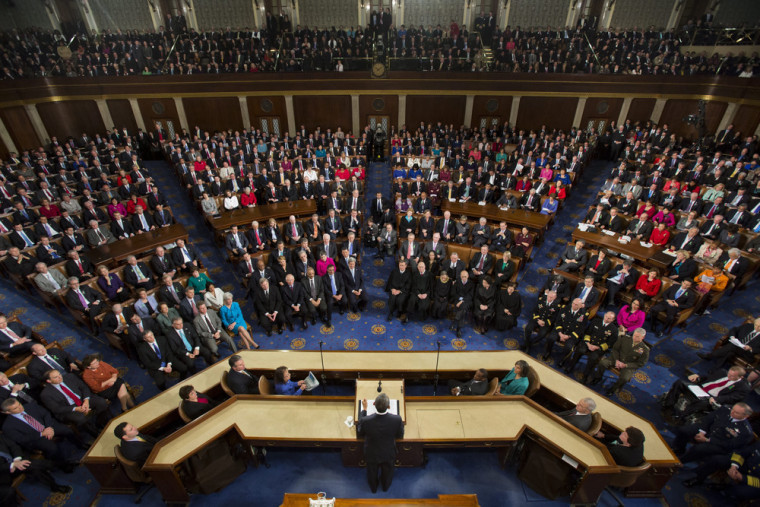
With sickly approval ratings and a stagnant Congress, President Barack Obama’s State of the Union address will likely be more of an opportunity to press the reset button than a feel-good TV presentation for his party.
State of the Union speeches typically include a laundry list of policy goals and requests for congressional action. But with Congress mostly spinning its wheels – with the notable exception of some possible traction on immigration reform – Obama’s remarks are likely to prompt substantial discussion of what he can – and can’t – do to bypass Capitol Hill entirely.
And, as the term “lame duck” increasingly creeps into the vocabulary used to describe the president’s future, Obama’s efforts to carve out his own legacy will be in the spotlight.
Here are six things to watch for during the president’s speech:
The Income Inequality Push – Economic fairness has always been a theme for the president, but it’s a defining one for Democrats now eyeing the midterm elections. And the party thinks it’s a winning issue: A new USA TODAY/ Pew Research Center poll shows that majorities of both Republicans and Democrats believe income inequality has been growing over the past decade. The same survey showed overwhelming support for extending the stalled jobless benefits for the long-term unemployed and for raising the minimum wage. Republicans also have their eyes on those numbers, with high-profile and possible 2016 GOPers like Sen. Rand Paul and Sen. Marco Rubio already pre-butting the president’s argument, arguing that the ‘War on Poverty” has fundamentally failed. (That same famed “War on Poverty” was itself launched in a State of the Union speech – by President Lyndon Johnson – 50 years ago.)
Explaining Executive Action – At the end of last year, Obama coined the term “Year of Action” to describe his administration’s approach to 2014. Since then, he’s been blunt about what that means: using executive action and the presidential bully pulpit (the “pen” and the “phone) to bypass a deadlocked Congress to achieve policy goals. Expect Obama to expand on that theme and be specific about what he’s asking Congress to do legislatively and what he intends to do without an OK from the Hill.
Words Matter on Immigration – With congressional Republicans poised to roll out their “principles” on immigration, watch the president’s wording on what he’s called his top domestic issue. Obama opened the door last year to accept what Republican House Speaker John Boehner calls a “step-by-step” approach to the problem as long as it checked the administration’s boxes. Key Republicans say that they’re open to a program that would grant legal status to most undocumented immigrants. The White House and its allies have been clear that they want a path to citizenship as well – but Obama won’t want his language to be perceived as too pushy right before the GOP embarks on the delicate effort to pass meaningful immigration legislation.
What about Guns? At the end of President Barack Obama’s 2013 State of the Union, Obama closed with a passionate plea for a “a simple vote” on legislation to address gun violence, invoking the victims of the Newtown and Aurora massacres, Gabby Giffords and the family of Chicago shooting victim Hadiya Pendleton. A year later, those proposals remain firmly stalled in Congress, with little hope of mustering enough support even to push any through the Democratically-controlled Senate. With locked-down schools and public violence becoming drearily familiar, Obama can scarcely fail to highlight the steps his administration has tried taking to beef up gun regulations at the executive level. But the sweeping federal legislation he wants isn’t going to happen anytime soon.
The Second Screen Experience – The White House doesn’t just want Americans to watch the SOTU. They want supporters to experience a multimedia, chock-full-of-charts production ripe with the kind of graphics and data that catch eyes on Facebook and Twitter. More than a week before the big night, WhiteHouse.Gov was already steering people towards this year’s “enhanced” viewing experience online. The White House had the same strategy last year; this year, they’re also pegging a follow-up “national Google+ Hangout” by the president to the State of the Union on January 31. It says a lot about our media environment – and about the multiple audiences (Congress, diehard backers, independents and casual viewers) he’s trying to reach.
SOTU Déjà vu –
“We must do more to combat climate change.”
“I realize that tax reform and entitlement reform will not be easy.”
“Send me a comprehensive immigration reform bill in the next few months, and I will sign it right away.”
Pundits can picture Obama uttering all of those phrases on Jan. 28, 2014. Trouble is: they’re all from LAST YEAR’s address. This January finds the second-term president in much the same place as last year, with the vast majority of his top agenda items snarled in Congress. And this year, he has the bungled early rollout of the Affordable Care Act to defend as well. A lot of this year’s big ticket items are going to sound very familiar to his audiences.